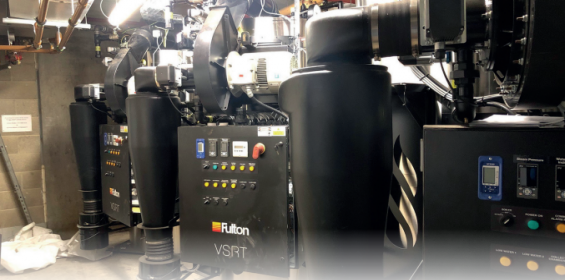With steam being essential to the University and used extensively for humidification purposes – to ensure that the appropriate environmental conditions of 55% to 65% RH are maintained – and for the autoclaving of equipment and waste, any installation needed a form of redundancy in place from the outset.
Installed in 2004 and handed over to the facilities team in 2005, the University’s original installation therefore featured three J Series boilers, allowing for two to cope with daily requirement and the third as a standby for when steam demand was high or during servicing and maintenance schedules on the other boilers.
UEA Estates Project Lead, Philip Page, commented: “Even during the original planning phases for the boiler plant room we knew that floorspace, headroom and access was going to be limited. With horizontal firetubes out of the question and many vertical boilers at the time requiring almost double the height of the boiler itself for maintenance purposes, Fulton’s J Series was the perfect solution.
“Fast forward to when we started the replacement programme for the J Series a review revealed that things, in the most part, hadn’t changed in the boiler market and no other boiler that could fit within the plant room was as capable or efficient. We therefore put the programme on hold.”
Replacement programme
Thankfully for the University, when the time did come to complete the replacement programme, a market review in 2019 revealed that Fulton had just launched its all-new VSRT, the most radical change to vertical steam boiler design since the company pioneered the vertical tubeless boiler back in 1949; and the world’s first fully wetted, refractory-free vertical tubeless boiler. The compact footprint of the VSRT also meant it was a perfect fit for the existing plant room.
Available with outputs from 160 to 960 kg/h, the VSRT boasts ultra-low NOx emissions of less than 20ppm, achieved thanks to the VSRT’s combustion technology that features a modulating burner and furnace that have been purposely designed as a single component and fully-matched with the VSRT in mind. This has helped Fulton to achieve up to 10:1 turndown capabilities and industry-leading performance of >82.5% gross thermal efficiency and 99.75% steam quality at 8 bar.
Having been in constant use for over 14 years, the University replaced all three Fulton J Series steam boilers with an all-new heat transfer system featuring three VSRT-50 boilers complete with all necessary ancillary plant including water treatment, chemical dosing, blowdown vessel and feedwater tank. Because of the plant room’s situation – located in the middle of the building on the second floor – a temporary steam main was installed and piped to an external boiler plant solution that was hired so the facility’s steam supply could be maintained. A crash desk was then built two floors up, the end wall of the building removed, and the J Series boilers removed and replaced with the VSRTs. In total, the entire replacement process took six weeks to complete.
Two years after the VSRT installation was commissioned and handed over to the University’s estates team, a review of energy savings was commissioned to compared the old and new installations, with the results proving significant.
“The sustainability team compared the last 12 months usage of the three VSRTs to that of the three J Series boilers’ pre-Covid usage in 2019 and has reported a reduction in gas consumption of nearly 28% and over 57% for water.” says Philip. “Even if you don’t to take into account the recent cost increases in gas, these savings are significant and really impressive!”.
Sustainability report
In addition to the gas and water savings, the sustainability report also identified an 85-tonne reduction in CO2 annually, savings that can be credited towards the University’s net zero goals. The University is also seeing an approximate 40% reduction in NOx emissions throughout the burner firing range.
As part of the new VSRT package, Fulton’s SCOPE boiler sequencing system was also specified which, as Philip Page explains, the University sees as being vital to the installation’s longevity:
“We operate an N+1 strategy at the University and most of the time two of the three boilers are firing to meet demand. The autoclaves are not always in use and during these times only one of the boilers is needed. However, we’re keen on maintaining equal operating hours across all three boilers and balancing water treatment across them too, so Fulton’s new SCOPE system enables us to automate weekly boiler changeovers to vary the lead boiler.”
And while Philip can’t attribute the savings achieved from the boiler installation to the SCOPE itself, he is confident that the sequencing system will help to reduce maintenance costs by balancing operating times across the three boilers.
Beyond the savings achieved, the University’s Estates team has also noted that compared to the J Series installation, the VSRTs are noticeably quiet in operation thanks in part to the fully modulating burners running at lower levels when steam demand is low.
Summarising, Philip Page says that in the years that the University had Fulton boilers they really do tick all boxes: “We can’t fault their operation, and we can’t fault the Fulton service or customer support.”
https://www.linkedin.com/company/fulton-boiler-works-gb-limited/

